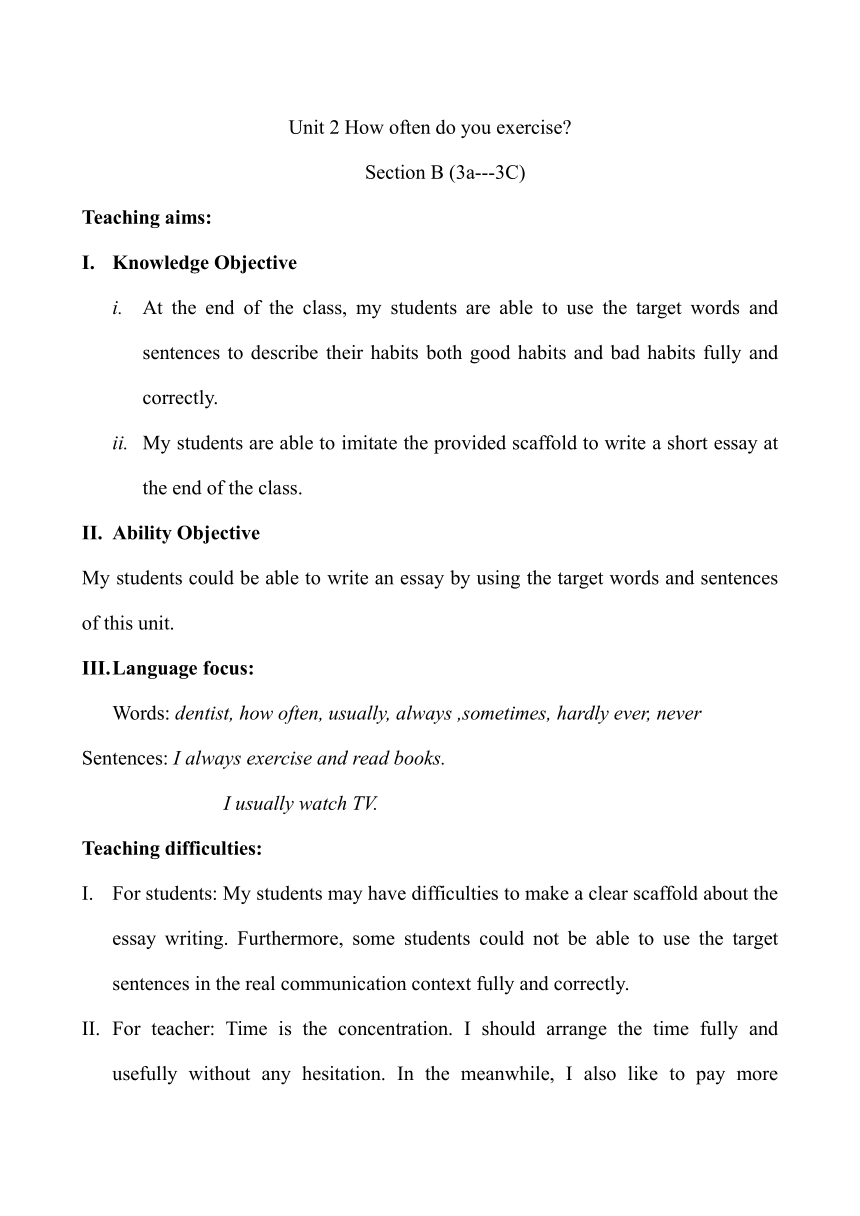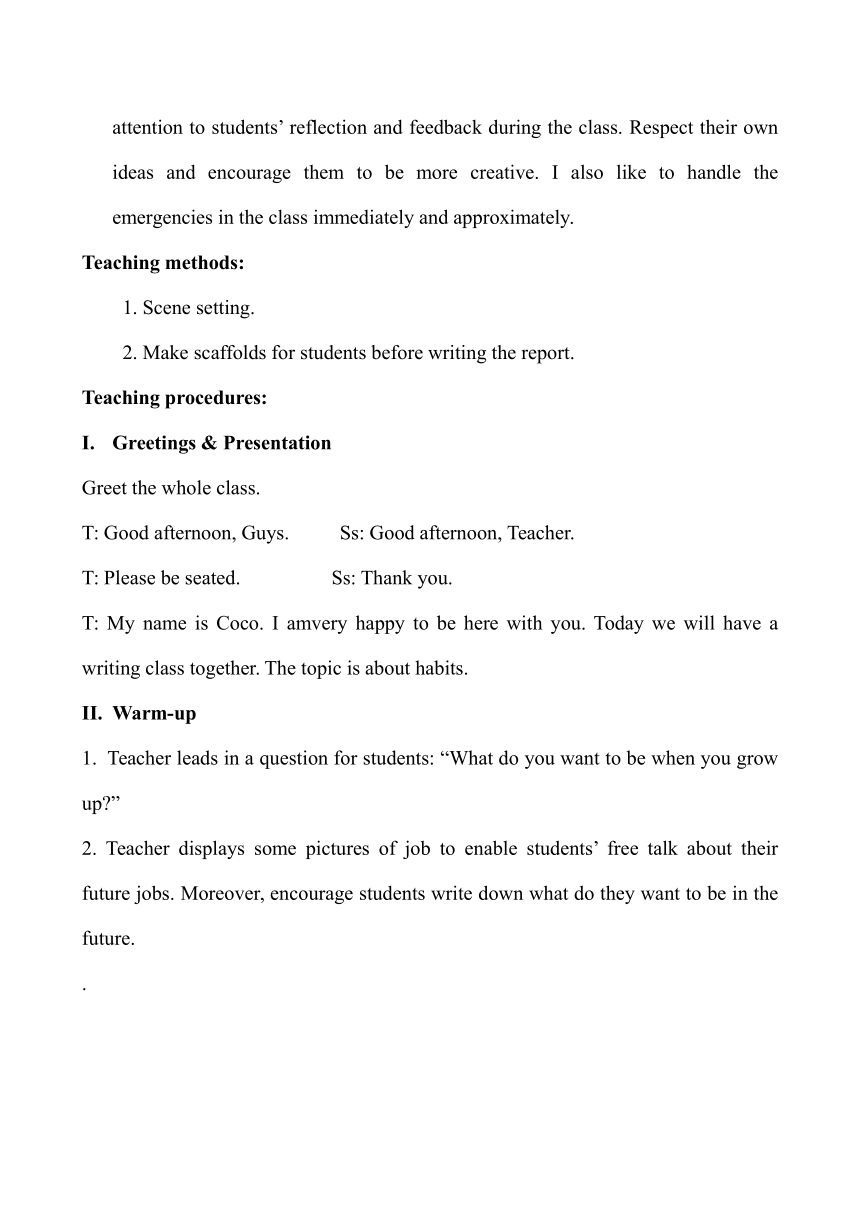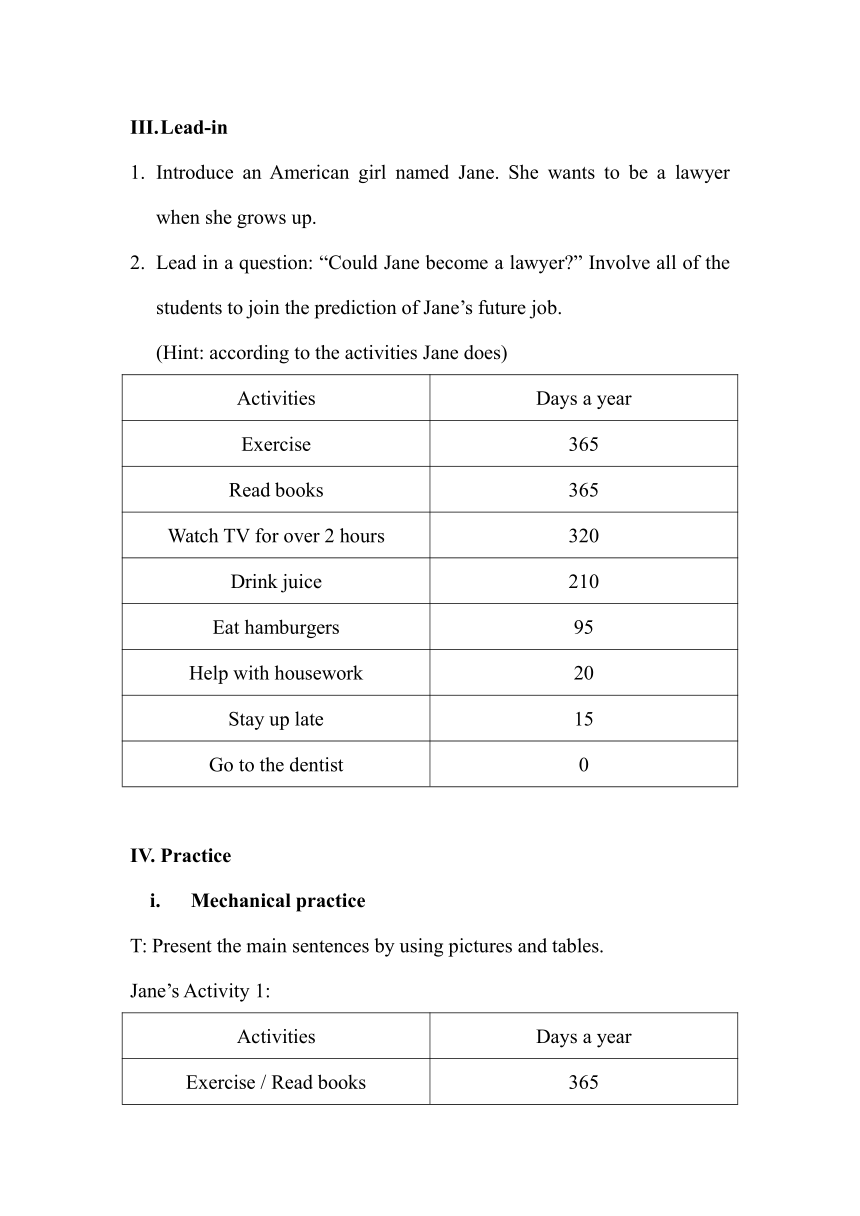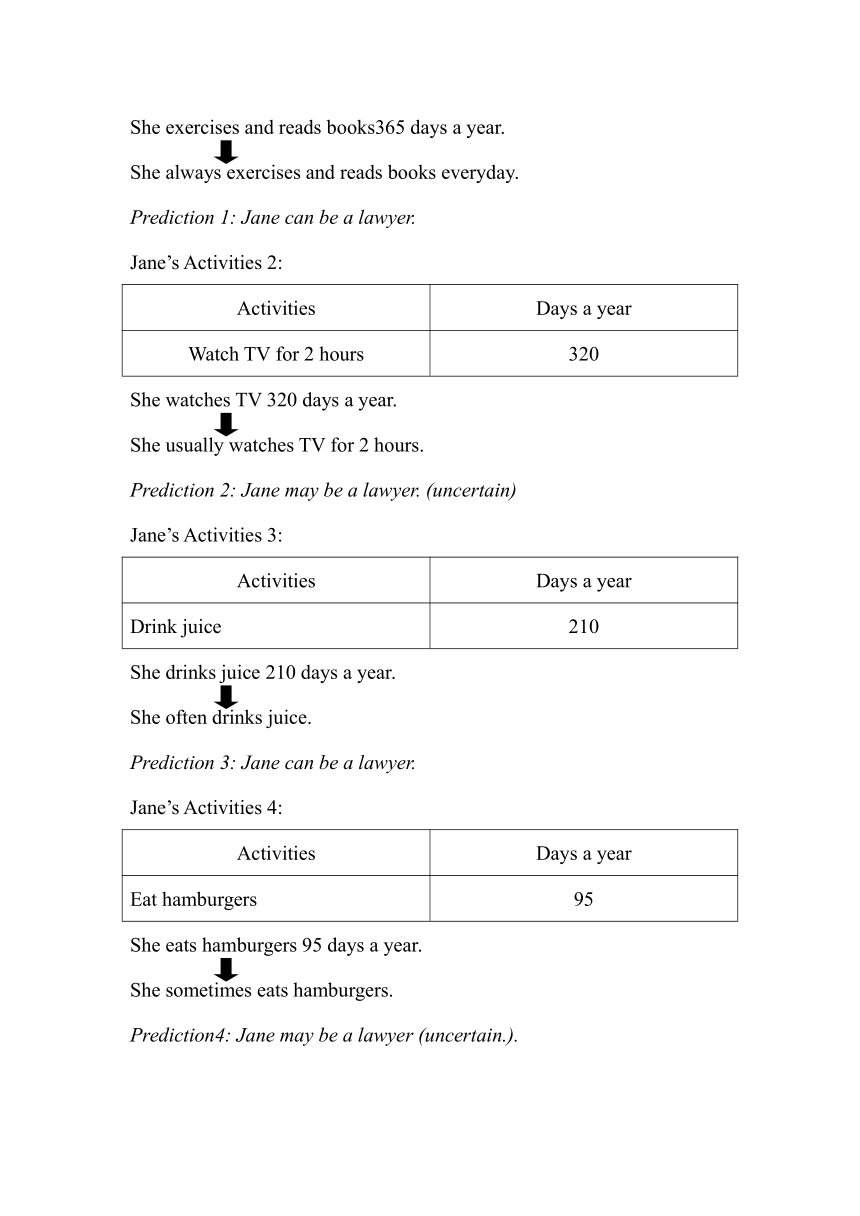人教版八年级上册英语 2.How often do you exercise?SectionB 3a-4 Self check 教案
文档属性
| 名称 | 人教版八年级上册英语 2.How often do you exercise?SectionB 3a-4 Self check 教案 |  | |
| 格式 | doc | ||
| 文件大小 | 69.0KB | ||
| 资源类型 | 教案 | ||
| 版本资源 | 人教新目标(Go for it)版 | ||
| 科目 | 英语 | ||
| 更新时间 | 2022-11-07 14:44:05 | ||
图片预览




文档简介
Unit 2 How often do you exercise
Section B (3a---3C)
Teaching aims:
Knowledge Objective
At the end of the class, my students are able to use the target words and sentences to describe their habits both good habits and bad habits fully and correctly.
My students are able to imitate the provided scaffold to write a short essay at the end of the class.
Ability Objective
My students could be able to write an essay by using the target words and sentences of this unit.
Language focus:
Words: dentist, how often, usually, always ,sometimes, hardly ever, never
Sentences: I always exercise and read books.
I usually watch TV.
Teaching difficulties:
For students: My students may have difficulties to make a clear scaffold about the essay writing. Furthermore, some students could not be able to use the target sentences in the real communication context fully and correctly.
For teacher: Time is the concentration. I should arrange the time fully and usefully without any hesitation. In the meanwhile, I also like to pay more attention to students’ reflection and feedback during the class. Respect their own ideas and encourage them to be more creative. I also like to handle the emergencies in the class immediately and approximately.
Teaching methods:
Scene setting.
Make scaffolds for students before writing the report.
Teaching procedures:
Greetings & Presentation
Greet the whole class.
T: Good afternoon, Guys. Ss: Good afternoon, Teacher.
T: Please be seated. Ss: Thank you.
T: My name is Coco. I amvery happy to be here with you. Today we will have a writing class together. The topic is about habits.
Warm-up
Teacher leads in a question for students: “What do you want to be when you grow up ”
2. Teacher displays some pictures of job to enable students’ free talk about their future jobs. Moreover, encourage students write down what do they want to be in the future.
.
Lead-in
Introduce an American girl named Jane. She wants to be a lawyer when she grows up.
Lead in a question: “Could Jane become a lawyer ” Involve all of the students to join the prediction of Jane’s future job.
(Hint: according to the activities Jane does)
Activities Days a year
Exercise 365
Read books 365
Watch TV for over 2 hours 320
Drink juice 210
Eat hamburgers 95
Help with housework 20
Stay up late 15
Go to the dentist 0
Practice
Mechanical practice
T: Present the main sentences by using pictures and tables.
Jane’s Activity 1:
Activities Days a year
Exercise / Read books 365
She exercises and reads books365 days a year.
She always exercises and reads books everyday.
Prediction 1: Jane can be a lawyer.
Jane’s Activities 2:
Activities Days a year
Watch TV for 2 hours 320
She watches TV 320 days a year.
She usually watches TV for 2 hours.
Prediction 2: Jane may be a lawyer. (uncertain)
Jane’s Activities 3:
Activities Days a year
Drink juice 210
She drinks juice 210 days a year.
She often drinks juice.
Prediction 3: Jane can be a lawyer.
Jane’s Activities 4:
Activities Days a year
Eat hamburgers 95
She eats hamburgers 95 days a year.
She sometimes eats hamburgers.
Prediction4: Jane may be a lawyer (uncertain.).
T: After presenting all of the sentences, there will be a discussion part about the prediction of Jane’s future.
Conclusion: What makes Jane’s dream uncertain Habits. Habits decide the future.
Meaningful practice
T: present a half control practice which including some provided information.
T: ask the students to turn to page 15 and read 3a. Then fill in the blanks according to the meaning of the text.
Jane is a 16-year-old high school student in the United States. American Teenager magazine asked her about her habits. Jane has a lot of good habits. She _______ exercises and she reads books ________. Also, she ________drinks juice and she __________ stays up late. However, she has some bad habits, too. She _______ watches TV for more than two hours a day, and she __________ eats hamburgers. Her parents are not very happy because she __________ helps with housework and she ______ goes to the dentist for teeth cleaning. She says she is afraid.
Group-work
T: Find out Jane’s habits.
Good habits: always exercises; always reads books; often drinks juice; hardly ever stays up late.
Bad habits: usually watches TV; sometimes eats hamburgers; hardly ever helps with housework; never goes to the dentist.
Communicative practice
T: What do you want to be in your future Let’s look at your habits and predict your future job. Can you be the person you want to be
3b Complete the chart with your own information. In the last column, use expressions like always, every day, twice a week and never.
Activities How often
Good habits
Bad habits
Activities: Exercise; Read books; Play computer games; Drink milk; Eat fruit and vegetables ; Eat junk food; Stay up late .
How often: always, every day, twice a week, never, hardly ever, usually,often...
Summarize the writing structure
How to write a report
Topic sentence
Good habits However Bad habits
Production
T: Write a report about your good and bad habits. Say how often you do things. Use the report in 3a as an example.
T: After writing, share your report to your classmates.
Tips:
1.Take notes about your classmates’
good habits and bad habits.
2.Let's predict about his or her future.
3.Give your own suggestions.
1. If students are in the English study high level, I would like to invite some students to make reports. Meanwhile, some other student will take notes about their classmates’ good habits and bad habits. After the report, all of the students in the class predict the future job and provide suggestion.
2. If students have problems to provide suggestion, the report will be ended just as reading the report. Teacher will lead students to provide the suggestion.
Board Design
How often do you exercise
Section B (3a---3c)
How to write a report
Topic sentence
Good habits However Bad habits
Frequency words:
Always
Usually
Often
Sometimes
Hardly ever
Never
Section B (3a---3C)
Teaching aims:
Knowledge Objective
At the end of the class, my students are able to use the target words and sentences to describe their habits both good habits and bad habits fully and correctly.
My students are able to imitate the provided scaffold to write a short essay at the end of the class.
Ability Objective
My students could be able to write an essay by using the target words and sentences of this unit.
Language focus:
Words: dentist, how often, usually, always ,sometimes, hardly ever, never
Sentences: I always exercise and read books.
I usually watch TV.
Teaching difficulties:
For students: My students may have difficulties to make a clear scaffold about the essay writing. Furthermore, some students could not be able to use the target sentences in the real communication context fully and correctly.
For teacher: Time is the concentration. I should arrange the time fully and usefully without any hesitation. In the meanwhile, I also like to pay more attention to students’ reflection and feedback during the class. Respect their own ideas and encourage them to be more creative. I also like to handle the emergencies in the class immediately and approximately.
Teaching methods:
Scene setting.
Make scaffolds for students before writing the report.
Teaching procedures:
Greetings & Presentation
Greet the whole class.
T: Good afternoon, Guys. Ss: Good afternoon, Teacher.
T: Please be seated. Ss: Thank you.
T: My name is Coco. I amvery happy to be here with you. Today we will have a writing class together. The topic is about habits.
Warm-up
Teacher leads in a question for students: “What do you want to be when you grow up ”
2. Teacher displays some pictures of job to enable students’ free talk about their future jobs. Moreover, encourage students write down what do they want to be in the future.
.
Lead-in
Introduce an American girl named Jane. She wants to be a lawyer when she grows up.
Lead in a question: “Could Jane become a lawyer ” Involve all of the students to join the prediction of Jane’s future job.
(Hint: according to the activities Jane does)
Activities Days a year
Exercise 365
Read books 365
Watch TV for over 2 hours 320
Drink juice 210
Eat hamburgers 95
Help with housework 20
Stay up late 15
Go to the dentist 0
Practice
Mechanical practice
T: Present the main sentences by using pictures and tables.
Jane’s Activity 1:
Activities Days a year
Exercise / Read books 365
She exercises and reads books365 days a year.
She always exercises and reads books everyday.
Prediction 1: Jane can be a lawyer.
Jane’s Activities 2:
Activities Days a year
Watch TV for 2 hours 320
She watches TV 320 days a year.
She usually watches TV for 2 hours.
Prediction 2: Jane may be a lawyer. (uncertain)
Jane’s Activities 3:
Activities Days a year
Drink juice 210
She drinks juice 210 days a year.
She often drinks juice.
Prediction 3: Jane can be a lawyer.
Jane’s Activities 4:
Activities Days a year
Eat hamburgers 95
She eats hamburgers 95 days a year.
She sometimes eats hamburgers.
Prediction4: Jane may be a lawyer (uncertain.).
T: After presenting all of the sentences, there will be a discussion part about the prediction of Jane’s future.
Conclusion: What makes Jane’s dream uncertain Habits. Habits decide the future.
Meaningful practice
T: present a half control practice which including some provided information.
T: ask the students to turn to page 15 and read 3a. Then fill in the blanks according to the meaning of the text.
Jane is a 16-year-old high school student in the United States. American Teenager magazine asked her about her habits. Jane has a lot of good habits. She _______ exercises and she reads books ________. Also, she ________drinks juice and she __________ stays up late. However, she has some bad habits, too. She _______ watches TV for more than two hours a day, and she __________ eats hamburgers. Her parents are not very happy because she __________ helps with housework and she ______ goes to the dentist for teeth cleaning. She says she is afraid.
Group-work
T: Find out Jane’s habits.
Good habits: always exercises; always reads books; often drinks juice; hardly ever stays up late.
Bad habits: usually watches TV; sometimes eats hamburgers; hardly ever helps with housework; never goes to the dentist.
Communicative practice
T: What do you want to be in your future Let’s look at your habits and predict your future job. Can you be the person you want to be
3b Complete the chart with your own information. In the last column, use expressions like always, every day, twice a week and never.
Activities How often
Good habits
Bad habits
Activities: Exercise; Read books; Play computer games; Drink milk; Eat fruit and vegetables ; Eat junk food; Stay up late .
How often: always, every day, twice a week, never, hardly ever, usually,often...
Summarize the writing structure
How to write a report
Topic sentence
Good habits However Bad habits
Production
T: Write a report about your good and bad habits. Say how often you do things. Use the report in 3a as an example.
T: After writing, share your report to your classmates.
Tips:
1.Take notes about your classmates’
good habits and bad habits.
2.Let's predict about his or her future.
3.Give your own suggestions.
1. If students are in the English study high level, I would like to invite some students to make reports. Meanwhile, some other student will take notes about their classmates’ good habits and bad habits. After the report, all of the students in the class predict the future job and provide suggestion.
2. If students have problems to provide suggestion, the report will be ended just as reading the report. Teacher will lead students to provide the suggestion.
Board Design
How often do you exercise
Section B (3a---3c)
How to write a report
Topic sentence
Good habits However Bad habits
Frequency words:
Always
Usually
Often
Sometimes
Hardly ever
Never
同课章节目录
- Unit 1 Where did you go on vacation?
- Section A
- Section B
- Unit 2 How often do you exercise?
- Section A
- Section B
- Unit 3 I'm more outgoing than my sister.
- Section A
- Section B
- Unit 4 What's the best movie theater?
- Section A
- Section B
- Unit 5 Do you want to watch a game show?
- Section A
- Section B
- Unit 6 I'm going to study computer science.
- Section A
- Section B
- Unit 7 Will people have robots?
- Section A
- Section B
- Unit 8 How do you make a banana milk shake?
- Section A
- Section B
- Unit 9 Can you come to my party?
- Section A
- Section B
- Unit 10 If you go to the party, you'll have a grea
- Section A
- Section B
